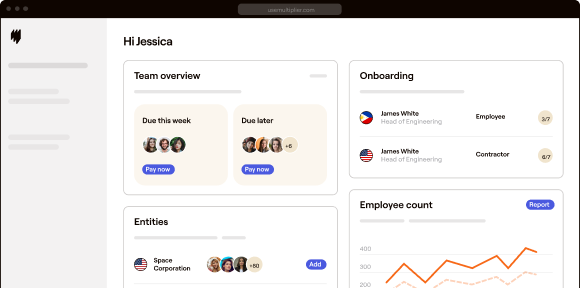The new business landscape is trending toward a more flexible, project-based workforce, and 1099 employees are spearheading that change. They are a growing segment of independent contractors who offer specialized expertise to clients.
These independent professional-cum-consultants offer businesses a dose of agility in picking up specific needs and connecting them with a much larger talent pool. Building a deep, strong understanding of how to work with 1099 employees effectively empowers businesses and independent contractors to maximize the potential of this dynamic work model.
This comprehensive guide is designed to navigate the complexities of the working relationship by covering why it makes a difference, along with the advantages, considerations for businesses, and knowledge necessary for the success of 1099 employees.
What is a 1099 employee?
1099 employees or independent contractors, as opposed to traditional employees on a company payroll, are self-employed service providers who offer their specialized skills to businesses through formal contracts.
Ever encountered a leaky faucet and sought the expertise of a licensed plumber? Or have you perhaps required a captivating logo for your business and sought the services of a skilled graphic designer? If yes, then, you’ve likely interacted with a 1099 worker. In essence, they act as independent business owners.
Companies often hire 1099 workers for specific projects demanding specialized expertise or a well-defined timeframe. This approach grants businesses greater flexibility in managing their workforce while minimizing the overhead costs associated with full-time employees.
For 1099 workers, this translates to the autonomy to choose projects that align with their interests, let them control their working hours, and enable collaboration with a diverse clientele.
A critical distinction between a 1099 worker and a traditional employee lies in the responsibility for managing taxes and benefits. Unlike employees who receive benefits such as health insurance, paid time-off, and retirement plans, 1099 workers are responsible for securing these benefits themselves.
The 1099 form: Tracking earnings efficiently
The term 1099 worker originates from the 1099 tax form utilized by companies to report payments made to independent contractors. There are various types of 1099 forms; however, the most common ones for independent contractors are the 1099-NEC (non-employee compensation) and the 1099-MISC (miscellaneous income).
These forms serve a crucial purpose for both contractors and companies, facilitating accurate earnings tracking for tax purposes.
The 1099 worker category encompasses a vast array of roles. Freelancers and consultants, gig workers, and self-employed professionals like graphic designers, writers, and software developers all fall under this umbrella.
Classification rules: 1099 worker rights
Assigning worker classifications can be a labyrinthine process, especially when it comes to 1099 employees, often referred to as independent contractors. Unlike the straightforward categories of full-time or part-time employees, 1099 contractors occupy a more nuanced space. However, by grasping the key factors and classifications, you can navigate this process with greater ease.
Two primary sets of rules govern worker classification as a 1099 employee: Those set by the Internal Revenue Service (IRS) and the Department of Labor (DOL).
The Internal Revenue Service (IRS) employs a three-pronged test, known as the “common law rules,” to determine if someone qualifies as an independent contractor. These factors all center around the level of control a business exerts over the worker:
- Behavioral control: Does the company dictate what the worker does and how they do it? This might involve setting schedules, providing detailed instructions, or requiring specific tools or materials. Independent contractors typically have more freedom in how they complete their tasks.
- Financial control: Does the business control financial aspects of the worker’s job, such as payment methods (hourly for employees, project-based for contractors), expense reimbursements, or who provides equipment and supplies?
- Type of relationship: Is there a written contract outlining the terms of the engagement? Does the worker receive employee-like benefits like health insurance, paid time off, or a pension plan? Independent contractors are typically responsible for their own benefits and have a more temporary or project-based relationship with the company.
The Department of Labor (DOL) takes a more comprehensive approach with a six-factor test that delves deeper into the economic realities of the working relationship. These factors go beyond just control to consider the business risks and opportunities borne by the worker:
- Opportunity for profit or loss: Can the worker influence their earnings through negotiation or business decisions that could result in profit or financial loss for their own venture?
- Investments by the worker and employer: Does the worker invest in their own tools and equipment, or are they provided by the company? Independent contractors typically invest in their own resources needed to complete the job.
- Degree of permanence: Is the work arrangement ongoing and indefinite or is it project-based or temporary? Employees tend to have a more permanent connection to the company.
- Nature and degree of control: Does the worker set their own schedule and work location, or are they subject to a company-mandated schedule and work environment? Independent contractors generally have more autonomy in when and where they work.
- Whether the work is an integral part of the business: Is the work performed by the worker essential to the core function of the business? If the worker’s role is critical to daily operations, they may be classified as an employee.
- Skills and initiative: Does the worker possess specialized skills or expertise not readily available within the company? Independent contractors often bring unique skillsets to the table.
Understanding these classifications can be even more helpful when considering the broader workforce categories. Here’s a quick breakdown of some common employee classifications:
- Full-time employee: These workers typically work a set number of hours per week and receive a regular salary or wages, along with employee benefits.
- Part-time employee: These workers work fewer hours per week than full-time employees and may or may not receive benefits.
- Contract employee: This term can be a bit ambiguous, but it often refers to someone hired for a specific project or timeframe with a defined end date. Depending on the specific nature of the work and the factors outlined above, they may be classified as either an employee or an independent contractor.
- Temporary Employee: These workers are hired to fill a temporary need within a company, such as covering for maternity leave or during busy seasons. They may be classified as either an employee or an independent contractor.
- Volunteer: These individuals contribute their time and skills without being paid for their services.
Consequences of misclassification: 1099 employees
There can be significant legal and financial repercussions for businesses that mistakenly categorize workers as independent contractors (1099) instead of regular employees. This includes:
- Back taxes and penalties: The Internal Revenue Service (IRS) might decide the company owes income and payroll taxes for the misclassified worker, along with substantial fines. This is especially true if they suspect deliberate misclassification.
- Lost wages and benefits: Misclassified workers can sue the company for lost wages, benefits like health insurance, and overtime pay they weren’t entitled to as a 1099 contractor.
- Employee rights: Unlike regular employees, 1099 contractors don’t receive overtime pay or health insurance. Misclassification deprives them of these legal rights, potentially leading to lawsuits from disgruntled workers.
- Form SS-8: If unsure about worker classification, businesses can file Form SS-8 with the IRS for official determination. However, this process can take up to half a year.
- Tax and legal advice: To avoid these issues, businesses with classification concerns should consult a tax professional or lawyer for guidance. They can help navigate the complexities and ensure proper worker classification, saving the company from costly mistakes.
What are 1099 employees’ rights or 1099 contractor rights?
While often referred to as “1099 employees,” these professionals are not technically company employees, but rather independent businesses of one.
This distinction comes with a unique set of freedoms and responsibilities. Let’s delve into the fourteen key rights that empower independent contractors to navigate their work with confidence.
Ownership of work: Independent contractors hold the reins when it comes to their intellectual property. The fruits of their labor, whether it’s compelling written content, innovative designs, or ingenious code, belong to them by default. Clients who desire ownership of the work produced by a contractor need to include a “work made for hire” clause within the contract.
Timely compensation: Independent contractors deserve to be paid promptly for their valuable services. The payment schedule and terms should be crystal clear and outlined in a written contract signed by both parties before any work commences. If a client fails to meet their payment obligations, the contractor has the legal right to pursue action to recover what’s rightfully theirs.
Subcontracting: Sometimes, a project might require a specific skillset that the contractor themself may not possess. In such cases, they have the right to subcontract a portion of the work to another qualified professional. This allows them to fulfill their contractual commitments while leveraging the expertise of others. However, transparency is key: it’s important to inform the client about any use of subcontractors and ensure they meet the project’s requirements.
Managing the business: Independent contractors are the captains of their own ships. From securing their own equipment and workspace to covering business expenses and filing self-employment taxes, they’re responsible for managing these aspects of their professional lives.
Freedom of work: Clients shouldn’t dictate how a contractor accomplishes their tasks, as long as the project deliverables are met according to the agreed-upon timeline. This freedom allows contractors to choose their work methods, set their schedules, and structure their workday in a way that optimizes their productivity and fosters creativity.
Formal contract: A formal written contract is an essential tool that safeguards both the contractor and the client. It should clearly define the project scope, timeline, payment terms, termination conditions, and the nature of the working relationship.
Flexible work schedules: Independent contractors generally enjoy the flexibility to determine their working hours. They can choose to work full-time, part-time, or take on projects that fit seamlessly into their existing schedule. However, clear communication with clients regarding their availability is crucial to ensure deadlines are met.
Location independence: Unlike traditional employees who typically work from a designated office, independent contractors have the freedom to choose their workspace. They can work from the comfort of their home, a collaborative co-working space, a bustling coffee shop, or any location that inspires them and allows them to complete their work effectively.
Building client base: Independent contractors aren’t restricted to working with just one client. They can take on projects from multiple clients simultaneously, as long as they can manage their workload effectively and meet all deadlines. This allows them to diversify their income stream and build a broader client base.
Marketing their expertise: Independent contractors have the right to actively market their services to potential clients. This can involve building a captivating website, creating professional online profiles, networking with other professionals in their field, or utilizing freelance platforms to connect with clients.
Prompt payments: Independent contractors are entitled to receive payment for the services they provide. Establishing a clear billing rate upfront and promptly invoicing clients upon completion of work are essential practices.
Challenging misclassification: If a contractor feels they are being misclassified as an independent contractor, they have the right to challenge this classification. This can involve filing an SS-8 form with the IRS to request a determination of their worker status.
Work environment: Independent contractors have the right to determine their working conditions, including their work environment, schedule, and methods. This allows them to create a work style that is conducive to their productivity, fosters creativity, and contributes to their overall well-being.
Rights not covered under the 1099 contractor laws:
Tax responsibilities: As independent contractors are self-employed, they’re responsible for paying their own self-employment taxes, which cover both the employer and employee portions of Social Security and Medicare. It’s their responsibility to track their income and expenses accurately and file taxes appropriately at the end of the year.
Paycheck: There are no guaranteed paychecks and overtime pay. 1099 contractors’ income depends on the gigs they land and the hours they hustle.
Compensation: Getting sick or injured can be a financial blow. Unlike regular employees, 1099 employees don’t have unemployment benefits or workers’ compensation to fall back on.
Benefits: Unlike employees, independent contractors are not entitled to employer-sponsored health insurance, retirement plans, or other benefits.
Stability: Freelance work can be a feast or famine. Contracts can end unexpectedly, and there’s no guarantee of a steady stream of clients.
Anti-discrimination laws: Freelancers might have less legal protection against discrimination compared to traditional employees.
Hiring 1099 employees: A step-by-step process
Step 1: Employee classification: The initial step hinges on correctly classifying the individual as a 1099 employee. This distinction holds significant weight for tax purposes and helps mitigate potential legal issues in the future. The Internal Revenue Service (IRS) utilizes a three-pronged test to determine worker classification:
Step 2: Verify credentials: As with any hiring decision, take the time to meticulously verify the freelancer’s qualifications and work history. This ensures they possess the skills and experience necessary to successfully complete the project. Request a portfolio and references, or ask them to complete a relevant test to gauge their expertise. For certain roles, background checks might be mandated by law.
Step 3: Craft a clear and comprehensive contract: A well-drafted contract serves a twofold purpose: it establishes a clear understanding of project expectations and helps solidify the 1099 classification. Here are some key elements to include:
- A detailed breakdown of the specific tasks the freelancer will undertake
- Defined criteria for evaluating the quality of the completed work
- Specification of whether the freelancer will utilize their own tools and equipment
- A clear payment schedule and method
- Intellectual property ownership rights, particularly relevant for creative projects
- Once both parties agree to the terms, have the freelancer sign a copy of the contract for your records.
Step 4: Essential paperwork completion: In addition to the contract, there are essential forms to complete for proper tax reporting:
- W-9: The IRS requires independent contractors to complete this form, providing their tax identification number and verifying their eligibility to work in the United States.
- 1099-NEC: This form reports the total payments made to the freelancer during the calendar year.
- Optional forms: Form SS-8 can be used to request an IRS determination on worker classification, offering additional peace of mind. For foreign contractors, form W-8BEN may be required for reporting earnings.
Making international employment easy
Understanding 1099 employee rights is crucial, but navigating the complexities of international employment contracts can be a nightmare. Let Multiplier’s Employer of Record (EOR) services take the heavy lifting off your shoulders.
- Build your dream team, anywhere: Hire top talent from over 150 countries without the hassle of setting up local entities. Multiplier acts as the legal employer, handling everything from payroll and taxes to benefits and compliance. Our user-friendly platform streamlines onboarding, timesheets, and expense management, allowing you to focus on what matters: building a world-class team.
- Reduce risks and simplify compliance: Our experts craft multilingual, compliant contracts, ensuring you navigate local labor and tax laws with confidence. We mitigate employment risks and ensure full compliance, protecting your business from costly mistakes.
- Offer competitive, homogeneous benefits: Provide your global workforce with competitive benefits and insurance, constantly updated to meet regional regulations. Customize insurance packages for each employee, ensuring everyone receives top-notch coverage.
- Effortless global payroll and expense management: Pay your international team in over 120 currencies with a single, consolidated invoice. Manage employee taxes, allowances, and deductions seamlessly. Our platform also empowers freelancers to submit invoices and receive payments quickly and easily.
Don’t let complex international employment regulations hinder your global ambitions. Focus on growing your business and let Multiplier take care of compliance. Partner with Multiplier.
FAQs
Q. What forms should I file for employees and independent contractors (regarding 1099 contractor rights)?
For traditional employees, you’ll need to file a W-2 form. For independent contractors, use the 1099-MISC form.
Q. What are the consequences of incorrectly classifying a worker?
Misclassifying workers can result in substantial fines and potential liability for unpaid wages or benefits.
Q. Is a written contract necessary for 1099 employees?
While not legally required, having a written contract can help protect your business and clarify expectations.
Q. How are payroll taxes treated for contractors?
Payroll taxes are not deducted from contractors’ payments. Contractors are responsible for managing their own tax obligations.
Q. Are contractors paid a fixed amount?
Contractors typically receive varying payments based on the specific projects they work on. Unlike employees, their compensation is project-based.
Q. Do 1099 laws apply to independent contractors?
Yes, 1099 laws do apply to independent contractors. These regulations govern tax reporting and documentation for contractors in the United States. Contractors often receive a Form 1099-MISC for tax purposes.
Q. Can a 1099 employee work full-time?
A 1099 employee is not a full-time employee. They may work full-time hours if specified in the contract but do not receive the same benefits as full-time employees.
Q. How many hours can a 1099 employee work?
A 1099 employee’s hours depend on the contract. There is no cap on hours unless specified. They don’t qualify for overtime.
Q. How many 1099 employees can a company have?
A company can have as many 1099 employees as needed, following proper classification and guidelines.
Q. What paperwork is needed for a 1099 employee?
Use Form 1099-NEC to report payments exceeding $600 annually. The 1099 employee fills out a Form W-9 for tax reporting.







